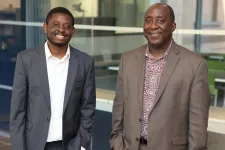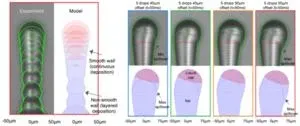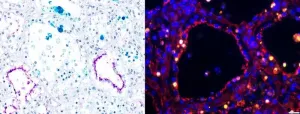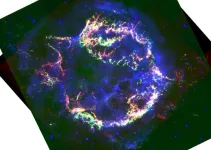(Press-News.org) UTICA, NY – The president of SUNY Polytechnic Institute (SUNY Poly), Dr. Winston “Wole” Soboyejo, and postdoctoral researcher, Dr. Tabiri Kwayie Asumadu, have published a revolutionary new paper titled, "Robust Macroscale Superlubricity on Carbon-Coated Metallic Surfaces." This paper explores an innovative approach to reducing friction on metallic surfaces – a significant advancement that could have major real-world impacts.
The study shows that superlubricity – a state with virtually no friction that was once believed to only be achievable at nanoscale – can now be maintained at macroscale for extended time periods under regular atmospheric conditions by employing sustainably produced carbon coatings made from biowaste.
These findings are significant for a number of practical reasons. In the automotive industry, more than 30 percent of fuel in passenger vehicles is used to overcome friction, so these novel coatings can help to drastically improve fuel efficiency. In manufacturing and industrial machinery, they could help to reduce wear and tear, leading to massive cost savings and decreasing the 1-4% of countries’ GDP that is spent on friction-related equipment issues. In electronic devices, friction at a minute scale can present large-scale challenges that coatings could help to alleviate.
“This research truly could touch most industries,” said Dr. Asumadu. “From biomedical to energy sectors to nearly every kind of manufacturing, this approach could help to extend the life of machine parts, reduce maintenance and replacement costs, and create a more sustainable industrial future.”
The paper was published in Applied Materials Today by a group of eight materials scientists collaborating across Africa and the Northeastern United States, including Mobin Vandadi, Desmond Edem Primus Klenam, Kwadwo Mensah-Darkwa, Emmanuel Gikunoo, Samuel Kwofie, and Nima Rahbar.
“My colleagues and I are extremely proud of this work, particularly for the environmental and economic implications it could have,” said Dr. Soboyejo. “We look forward to seeing the breakthroughs in friction management technologies that will happen as researchers operationalize these approaches.”
A B S T R A C T
This paper discusses experimental and computational results of ultralow (near-zero) friction of carbon-coated metallic depositions on substrates of structural steels, Ti, and Ni alloys. The macroscale superlubricity was demonstrated and sustained over several cycles through structurally misoriented carbon coatings on the metallic surfaces. Carbon nanocrystals with variants of graphene footprints were deposited on these metallic surfaces using a novel high temperature biowaste treatment process. The carbon nanocrystals deform, flatten, and coalesce in the wear tracks to form graphitic films leading to a superlubricious coefficient of friction of ~0.003. A coating life of ~150,000 cycles with reduced wear rates was obtained on Ni and steel substrates. The experiments were validated with atomistic simulations providing mechanistic insights into the effects of the graphene variants on the observed frictionless conditions. The underlying mechanisms of the coating/substrate interactions contributing to the macroscale superlubricity are elucidated. The implications of the current results are explored for designing robust and low-cost macroscale superlubricious carbon coatings on metallic substrates. Biowaste is a carbon source within a circular economy that uses material recycling to reduce the global carbon footprint.
About SUNY Polytechnic Institute (SUNY Poly)
SUNY Poly is charting a path to become New York State’s and the nation’s premier public polytechnic. The university offers undergraduate and graduate degrees – via its four colleges: Arts & Sciences, Business, Engineering, and Health Sciences – in engineering, cybersecurity, computer science, and the engineering technologies; professional studies, including business, communication, and nursing; and arts and sciences, including biology, game design, mathematics, and social sciences at its campus located in Utica. Established in 1966 as the Upper Division College at Herkimer/Rome/Utica, SUNY Poly today operates as an innovative academic leader and economic driver in the Mohawk Valley region and beyond. For more information, visit www.sunypoly.edu.
END
New research shows a frictionless state can be achieved at macroscale
SUNY Poly president and postdoc's research may enable economic and environmental breakthroughs across industry
2024-07-15
ELSE PRESS RELEASES FROM THIS DATE:
A novel and unique neural signature for depression revealed
2024-07-15
HOUSTON - (July 15, 2024) - As parents, teachers and pet owners can attest, rewards play a huge role in shaping behaviors in humans and animals. Rewards – whether as edible treats, gifts, words of appreciation or praise, fame or monetary benefits – act as positive reinforcement for the associated behavior. While this correlation between reward and future choice has been used as a well-established paradigm in neuroscience research for well over a century, not much is known about the neural process underlying it, namely how the brain encodes, ...
Academic psychiatry urged to collaborate with behavioral telehealth companies
2024-07-15
Waltham — July 15, 2024 — The strengths of academic psychiatry departments and the fast-growing private telehealth sector are complementary, according to a Perspective article published in Harvard Review of Psychiatry, part of the Lippincott portfolio from Wolters Kluwer. Justin A. Chen, MD, MPH, a psychiatrist at Weill Cornell Medicine in New York City, and colleagues reviewed literature on provision of outpatient mental health care in the United States. They concluded that academic psychiatry departments and telehealth companies could mutually benefit from strategic collaboration.
Academic medical centers struggle to ...
NASA’s Webb investigates eternal sunrises, sunsets on distant world
2024-07-15
Researchers using NASA’s James Webb Space Telescope have finally confirmed what models have previously predicted: An exoplanet has differences between its eternal morning and eternal evening atmosphere. WASP-39 b, a giant planet with a diameter 1.3 times greater than Jupiter, but similar mass to Saturn that orbits a star about 700 light-years away from Earth, is tidally locked to its parent star. This means it has a constant dayside and a constant nightside—one side of the planet is always exposed to its star, while the other is always shrouded in darkness.
Using Webb’s NIRSpec (Near-Infrared ...
Receptors make dairy cows a prime target for influenza, ISU team finds
2024-07-15
AMES, Iowa – As highly pathogenic avian influenza has spread in dairy herds across the U.S., the virus is being detected in raw milk. A new study by a broad team of researchers at Iowa State University’s College of Veterinary Medicine helps explain why.
Sialic acid, a sugar molecule found on the surface of some animal cells, acts as a receptor for influenza. Without sialic acid providing an entry point to attach, invade and infect, a flu virus is unlikely to find a potential host hospitable.
Before the recent HPAI outbreak ...
A new neural network makes decisions like a human would
2024-07-15
Humans make nearly 35,000 decisions every day, from whether it’s safe to cross the road to what to have for lunch. Every decision involves weighing the options, remembering similar past scenarios, and feeling reasonably confident about the right choice. What may seem like a snap decision actually comes from gathering evidence from the surrounding environment. And often the same person makes different decisions in the same scenarios at different times.
Neural networks do the opposite, making the same decisions each time. Now, Georgia Tech researchers in Associate Professor Dobromir Rahnev’s lab are ...
Wojtusiak to use artificial intelligence to help caregivers with social isolation
2024-07-15
Janusz Wojtusiak, Professor, Health Administration and Policy, College of Public Health, is set to receive funding for the project: “An Artificial Intelligence Solution to Social Isolation and Longlines of Caregivers of People with Dementia.”
Wojtusiak and his graduate student Ghaida Alsadah will lay the foundation for a large study aimed at utilizing AI methods to address social isolation and loneliness among people who care for those with Alzheimer’s Disease and those suffering from dementia.
Addressing ...
You're just a stick figure to this camera
2024-07-15
Images
A new camera could prevent companies from collecting embarrassing and identifiable photos and videos from devices like smart home cameras and robotic vacuums. It's called PrivacyLens and was made by University of Michigan engineers.
PrivacyLens uses both a standard video camera and a heat-sensing camera to spot people in images from their body temperature. The person's likeness is then completely replaced by a generic stick figure, whose movements mirror those of the person it stands in for. The accurately animated stick figure allows a device relying on the ...
Scorching storms on distant worlds revealed in new detail
2024-07-15
Astronomers have created the most detailed weather report so far for two distant worlds beyond our own solar system.
The international study – the first of its kind – reveals the extreme atmospheric conditions on the celestial objects, which are swathed in swirling clouds of hot sand amid temperatures of 950C.
Using NASA’s powerful James Webb Space Telescope (JWST), researchers set out to capture the weather on a pair of brown dwarfs – cosmic bodies that are bigger than planets but smaller than stars.
These brown dwarfs, named collectively ...
JWST unveils stunning ejecta and CO structures in Cassiopeia A's young supernova
2024-07-15
July 15, 2024, Mountain View, CA -- The SETI Institute announced the latest findings from the James Webb Space Telescope (JWST) of the supernova remnant, Cassiopeia A (Cas A). These observations of the youngest known core collapse supernova in the Milky Way provide insights into the conditions that lead to the formation and destruction of molecules and dust within supernova ejecta. The study’s findings change our understanding of dust formation in the early universe in the galaxies detected by JWST 300 million years after the Big Bang. ...
UC Irvine Earth system scientists discover missing piece in climate models
2024-07-15
Irvine, Calif., July 15, 2024 — As the planet continues to warm due to human-driven climate change, accurate computer climate models will be key in helping illuminate exactly how the climate will continue to be altered in the years ahead.
In a study published in the Journal of Geophysical Research: Atmospheres, a team led by researchers from the UC Irvine Department of Earth System Science and the University of Michigan Department of Climate and Space Sciences and Engineering reveal how a climate model commonly used by geoscientists currently overestimates ...
LAST 30 PRESS RELEASES:
Common brain parasite can infect your immune cells. Here's why that's probably OK
International experts connect infections and aging through cellular senescence
An AI–DFT integrated framework accelerates materials discovery and design
Twist to reshape, shift to transform: Bilayer structure enables multifunctional imaging
CUNY Graduate Center and its academic partners awarded more than $1M by Google.org to advance statewide AI education through the Empire AI consortium
Mount Sinai Health system receives $8.5 million NIH grant renewal to advance research on long-term outcomes in children with congenital heart disease
Researchers develop treatment for advanced prostate cancer that could eliminate severe side effects
Keck Medicine of USC names Christian Pass chief financial officer
Inflatable fabric robotic arm picks apples
MD Anderson and SOPHiA GENETICS announce strategic collaboration to accelerate AI-driven precision oncology
Oil residues can travel over 5,000 miles on ocean debris, study finds
Korea University researchers discover that cholesterol-lowering drug can overcome chemotherapy resistance in triple-negative breast cancer
Ushikuvirus: A newly discovered giant virus may offer clues to the origin of life
Boosting the cell’s own cleanup
Movement matters: Light activity led to better survival in diabetes, heart, kidney disease
Method developed to identify best treatment combinations for glioblastoma based on unique cellular targets
Self-guided behavioral app helps children with epilepsy sleep earlier
Higher consumption of food preservatives is associated with an increased risk of type 2 diabetes
NTU Singapore-led team captures first-ever ‘twitch’ of the eye’s night-vision cells as they detect light, paving the way for earlier detection of blindness-causing diseases
Global aviation emissions could be halved through maximising efficiency gains, new study shows
Fewer layovers, better-connected airports, more firm growth
Exposure to natural light improves metabolic health
As we age, immune cells protect the spinal cord
New expert guidance urges caution before surgery for patients with treatment-resistant constipation
Solar hydrogen can now be produced efficiently without the scarce metal platinum
Sleeping in on weekends may help boost teens’ mental health
Study: Teens use cellphones for an hour a day at school
After more than two years of war, Palestinian children are hungry, denied education and “like the living dead”
The untold story of life with Prader-Willi syndrome - according to the siblings who live it
How the parasite that ‘gave up sex’ found more hosts – and why its victory won’t last
[Press-News.org] New research shows a frictionless state can be achieved at macroscaleSUNY Poly president and postdoc's research may enable economic and environmental breakthroughs across industry




